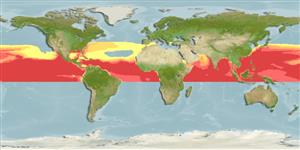Environment: milieu / climate zone / depth range / distribution range
Ecologie
marien; oceanodroom (Ref. 51243); diepte 0 - ? m. Tropical; 42°N - 36°S, 180°W - 180°E (Ref. 93339)
Circumglobal: all oceans preferably open ocean waters.
Atlantic: northward from 37°N in the western part of the ocean to 25° N in the eastern part and southward from 30° S in the western part to 8° S in the eastern part; somewhat broader in the Eastern Atlantic. It is quite rare in the Caribbean (except for the eastern part) and in the Gulf of Mexico.
Indian Ocean: Arabian Sea and Bay of Bengal in the north to the southern end of Africa and the western coast of Australia in the south; not found in the Red Sea, Aden, Oman and the Persian Gulfs, as well as in the easternmost part of the Indian Ocean in the waters between the southern Indonesian islands and the northern coast of Australia. Juveniles are distributed throughout the range of the species except in the most southwestern areas from the Mozambique Channel to the False Bay and in the waters off the west coast of Australia; juveniles were found in all seasons.
Pacific Ocean: northward from the northwestern tip of the Honshu Island in the west to 20° N in the east, and southward from the east coast of Australia to the waters of Ecuador and
Peru. Absent in the East China, Yellow and Japan Seas, quite rare in the South China Sea, none in the inner Indonesian seas.
Grootte / Gewicht / Leeftijd
Maturity: Lm ? range ? - ? cm
Max length : 25.1 cm SL mannelijk / geslacht onbekend; (Ref. 93339)
Dorsale stekels (totaal): 0; Dorsale zachte stralen (totaal): 10-12; Anale stekels 0; Anale zachte stralen: 11 - 13. Body dark, iridescent blue above, silvery white below; dorsal and caudal fins greyish, other fins hyaline (Ref. 2797). Juveniles elongate, paired fins mottled (Ref. 2797).
Found in oceanic surface waters (Ref. 9839). Caught in surface waters over the depths 80-10,400 meters, usually 2000 to 6000 m (mean 4423 m) (Ref. 93339). Spawns throughout the year in warm waters (Ref. 6523).
Levenscyclus en paargedrag
Maturiteit | Voortplanting | Paaien | Eieren | Fecunditeit | Larven
Shakhovskoy, I.B. and N.V. Parin, 2013. A review of flying fishes of the subgenus Hirundichthys (genus Hirundichthys, Exocoetidae). 1. Oceanic species: H. speculiger, H. indicus sp. nova. J. Ichthyol. 53(2):117-145. (Ref. 93339)
Status op de Rode Lijst van het IUCN (Ref. 130435)
Gevaar voor de mens
Harmless
Gebruik door de mens
Visserij: van minder commercieel belang
Meer informatie
Lokale namenSynoniemenMetabolismePredatorenEcotoxicologieVoortplantingMaturiteitPaaienPaaiaggregatiesFecunditeitEierenOntwikkeling van de eieren
ReferentiesAquacultuurAquacultuurprofielKweeklijnenGeneticaElectrophoresesErfelijkheidZiektesVerwerkingNutrientsMassaconversie
Tools
Speciale rapporten
Download XML
Internetbronnen
Estimates based on models
Preferred temperature (Ref.
123201): 1.2 - 2.9, mean 1.5 °C (based on 26666 cells).
Fylogenetische diversiteitsindex (Ref.
82804): PD
50 = 0.5002 [Uniqueness, from 0.5 = low to 2.0 = high].
Bayesian length-weight: a=0.00646 (0.00292 - 0.01429), b=3.04 (2.84 - 3.24), in cm total length, based on LWR estimates for this (Sub)family-body shape (Ref.
93245).
Trofisch niveau (Ref.
69278): 3.0 ±0.08 se; based on food items.
Weerstandsvermogen (Ref.
120179): Hoog, minimale populatieverdubbelingstijd minder dan 15 maanden (Preliminary K or Fecundity.).
Fishing Vulnerability (Ref.
59153): Low vulnerability (21 of 100).
